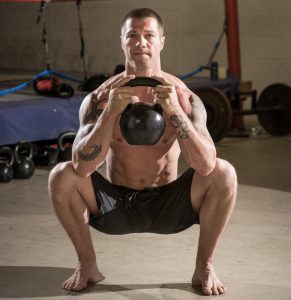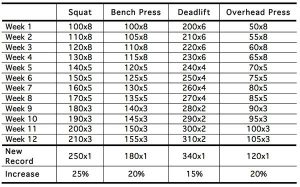By Marty Gallagher
Squat mastery is an important longevity tool. As we age we lose our flexibility and mobility. Below is a step by step process to regain this lost skill that a baby intuitively understands through the benefits of strength training.
Ultra-deep, Paused, Weightless Squat

Behold squat perfection: We are born with the ability to squat perfectly. Life causes us to lose this innate ability; our strategy is to “relearn” and recapture lost “primordial wisdom.” Note knees over ankles, vertical shins, upright torso; pelvis is tucked under. Baby will rise up using leg power alone. This is our core technique, our foundational position for all subsequent squats.
Key Technical Points
- This first variation is the key squat technique, the foundation on which all subsequent squat variations are built. Learn it, master it.
- Find an appropriate stance width: not too wide and not too narrow.
- Sit back upon breaking knees.
- Keep weight balanced mid-foot; do not shift forward or backwards.
- Imagine a stake driven through the mid-foot to keep one grounded.
- On ALL squat variations, knees are FORCED out during descent and ascent.
- Synchronize the inhalation with descent.
- Arms can be used as counter-balance during descent and ascent.
- Diaphragm breathing; inhale pushing pressure into the lower abdominal.
- Knees should stay over ankles as much as possible.
- Knees should never travel out in front of toes.
- Ass-on-heels, we mimic the baby, we go all the way down.
- In the bottom position, exhale; relax and sink further, lose all tension.
- Inhale to ascend; use diaphragm breathing; push gut out against thighs.
- Alternate technique: inhale, sink to bottom and arise, exhale at top.
- When ascending DO NOT let the tailbone shoot up first!
- Perform three sets of 20 paused reps.
- If technique breaks down, curtail the set immediately.
Ultra-deep, Paused, Kettlebell Goblet Squat

Key Technical Points
- Hold a kettlebell in “goblet” position.
- Alternatively, hold twin kettlebells in “clean” position.
- Adhere to all the technical points of the paused weightless squat.
Ultra-deep, Paused Barbell Front Squat

Olympic champ Niam Suleymanoglu: front squat perfection. 463 pounds weighing 132; note vertical shins and torso.
Key Technical Points
- Position a barbell in the squat rack. Step under bar facing it.
- Use “press grip” or the “cross-hand” over-grip.
- Ankles should be under the barbell, rotate pelvis forward, stand erect.
- Step back; take several “adjustment” steps.
- Adhere to all the technical points of the no-weight and goblet squat.
- Sit back, knees over ankles, descend all the way, knees forced outward.
- The lower you descend, the higher elbows are raised.
- At the bottom point, exhale; allow poundage to drive you down further.
- Pause at the bottom while maintaining an upright torso.
- Breath using the diaphragm; fill lower abdominal region with pressure.
- Alternate technique: inhale, sink to bottom and arise, exhale at top.
- Come erect; DO NOT let the tailbone rise up at “turnaround.”
Ultra-deep, Paused Hi-bar Barbell Back Squat

Hi-Bar squat perfection: Olympic champion Anatoli Piserenko gives 738×3 a ride: note depth and position
Key Technical Points
- Facing barbell, place left hand on bar, then right hand, grip width optional.
- Step under bar until ankles are under barbell.
- The bar sits on back where neck meets the trapezius in hi-bar position.
- Rotate pelvis under, stand straight up.
- Step back and take adjustment steps.
- Stance width is identical in previous squat variations.
- Adhere to all technical points used in previous squat variants.
- Inhale using diaphragm breathing; at low point exhale.
- Allow poundage to push you to the bottommost position.
- When time to ascend, inhale mightily using diaphragm inhalation.
- Alternate technique: inhale, sink to bottom and arise, exhale at top.
- Maintain upright torso; knees over ankles; knees forced out throughout.
- Push upwards without allowing to tailbone to rise up.
Slightly-below Parallel, No Pause, Low-bar Back Squat

The greatest squat technician in history: Doug Furnas squats 880 weighing 220. Note uprightness of torso, perfect depth, knees pinioned outward. This is structural and architectural perfection. I coached Doug at National and World Championships. Doug eventually squatted 986 pounds.
Key Technical Points
- Facing barbell, place left hand on bar, then right hand, grip width optional.
- Step under bar until ankles are under barbell.
- Bar sits lower on back; on muscle shelf atop rear delts in “low-bar” position.
- Rotate pelvis under, now stand straight up.
- Step back and take requisite adjustment steps.
- Stance width is identical to all previous squat variations.
- Inhale using diaphragm breathing on the descent.
- Descend to a point where upper thighs are slightly below parallel to the floor.
- At turnaround, arise explosively.
- Maintain inter-abdominal pressure on descent and thru 2/3rds of ascent.
- Exhale 2/3rds of the way erect.
- Maintain upright torso throughout – keep knees over ankles throughout.
- Push upwards without allowing to tailbone to rise up.
- The knees forced out throughout.
How to Periodize
In the world of strength training the use of periodization is standard operating procedure and should become an integral part of your training. Periodization is another word for preplanning. Elite strength athletes will lay out 3-4 months of preplanned workouts ahead of time; identifying target poundage, number of sets and reps for each and every workout.
Hall of Fame lifter (and current world record holder) Kirk Karwoski and I would lay out his periodized training template twice a year: before the national championships and world championships. For the last few years of his career he was able to complete an entire 12-week periodized game plan without missing a single preplanned set, rep and poundage target. Other greats such as Ed Coan and Doug Furnas were equally adept.

Kirk Karwoski squats 1003 pounds at the 1995 Nationals.
Here is how an individual with a 200 pound squat, a 150 pound bench press, a 300 pound deadlift and a 100 pound overhead press might lay out a 12 week periodized game plan. Each set and rep combination is performed after taking as many warm-up sets as needed.
This template can be modified and utilized regardless current strength levels.

Key Points
- All lifts start off at approximately 50% to 65% of current max
- All lifts end up roughly 15% to 25% above current max
- All lifts utilize pristine technique
- Optional: In early phases, multiple top sets can be used
- Never start off too high or too low
Creating Your Own
Periodized Training Template
In a nutshell, the way to periodize or “cycle” any lift is as follows….
- Create a realistic goal
- Establish a realistic timeframe
- Reverse engineer: work backwards with a calendar, pen and legal pad
- Place the realist goals within a specified timeframe
- Work backwards to establish weekly poundage benchmarks
- Every 3-4 weeks alter the variables in anticipation of stagnation
- When instituting changes, make them dramatic, not minor
Scenario: let us assume a 195 pound individual is athletic, but slightly out-of-shape coming off the winter holidays; he wants to take ten weeks to lean out and shape up. His previous deadlift best was 390×1 and his leanest, most athletic and functional bodyweight in the past has been 185-188 pounds.
In ten weeks time our hypothetical individual has morphed from a soft 195 into a rock hard 180 pounds. His deadlift, a great overall strength indicator, has leapt upward by a full 10%, from 390 for 1 rep to 435 for 1. He has regained his cardio condition by tweaking his run durations and weekly frequencies. In 70 days he has gotten himself into prime fighting condition. This is a fairly conservative example and mirrors what I do with clients and students every single week.
